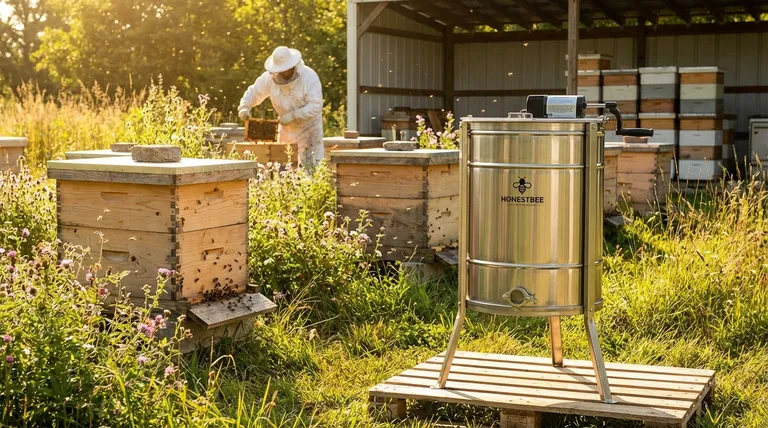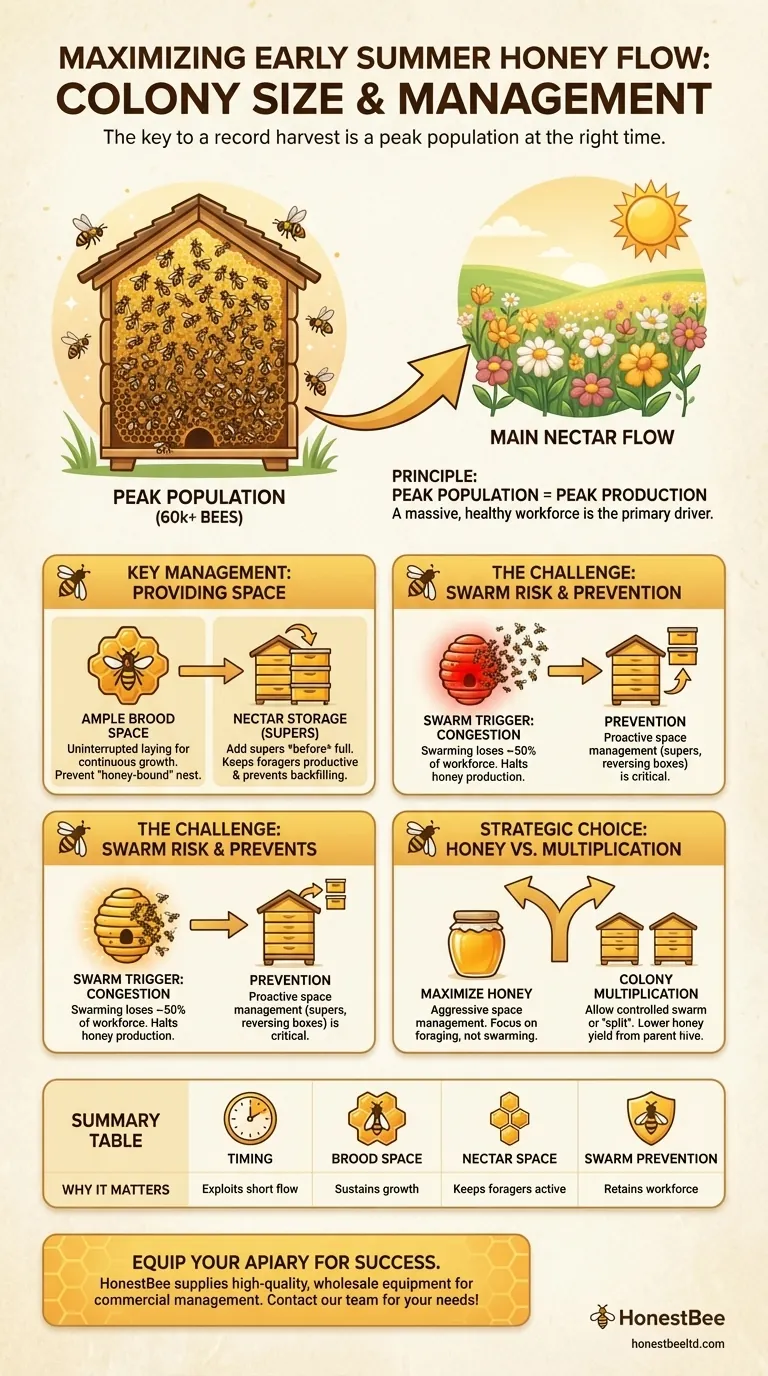For a successful honey harvest, your primary goal is to ensure your colony reaches its maximum population size precisely as the main nectar flow begins in early summer. This single factor—a massive, healthy workforce ready to forage—is the most critical driver of honey production. A smaller colony simply lacks the bee-power to take full advantage of the temporary abundance nature provides.
The challenge isn't just having a large population, but managing the hive's internal space. A beekeeper must proactively provide room for the queen to lay and for foragers to store incoming nectar, or else the colony's strength will trigger a swarm, effectively halting honey production.

The Principle of Peak Population
A large honey harvest is a direct result of a large foraging force. The internal dynamics of the hive dictate how many bees are available for this crucial task.
The Forager-to-Brood Ratio
In any colony, bees are divided between in-hive tasks (like tending to brood) and foraging. A small, growing colony dedicates a high percentage of its population to raising young bees.
A large, mature colony has a much more favorable ratio. With a massive population, the proportion of bees needed for brood care is smaller, freeing up an enormous workforce of experienced foragers to collect nectar.
The "Critical Mass" Effect
A colony with over 60,000 bees doesn't just collect twice as much honey as a colony with 30,000 bees; it can collect many times more.
This is because a larger workforce can deploy thousands of foragers to exploit a strong nectar flow efficiently. They also regulate hive temperature and humidity with less effort per bee, freeing up even more of the population for fieldwork.
Key Management Considerations for a Strong Colony
Achieving peak population at the right time requires proactive management in the weeks leading up to the nectar flow. You must anticipate the colony's needs for space.
Ensuring Ample Brood Space
The queen is the engine of population growth. To build a massive workforce, she must have uninterrupted space to lay eggs in the weeks before the main flow.
If the brood nest becomes congested or "honey-bound" (filled with nectar), her laying rate will plummet. This stalls population growth at the most critical moment.
Providing Nectar and Pollen Storage
Foragers need an empty place to deposit incoming nectar immediately. If they cannot find storage, they will stop foraging and begin filling cells in the brood chamber.
This is why you must add honey supers (boxes with empty frames) before the hive is full. Providing this space keeps the foragers working and prevents nectar from clogging the brood area.
The Importance of Timing
Your goal is for the bee population to peak simultaneously with the start of the main nectar flow.
If the population peaks too early, the colony may consume its resources or swarm before the flow begins. If it peaks too late, the bees will miss the period of greatest abundance. Understanding your local floral calendar is essential.
Understanding the Trade-offs: The Risk of Swarming
The very conditions that create a powerful honey-producing colony—a large population and a strong nectar flow—are also the primary triggers for swarming.
What Triggers a Swarm?
Swarming is a natural method of reproduction for a honey bee colony. It is primarily triggered by congestion.
When the brood nest is crowded with bees and the queen has nowhere to lay, the colony begins preparations to divide. A heavy, sudden nectar flow can rapidly fill all available space, dramatically increasing this pressure.
Proactive Swarm Prevention
Preventing a swarm is the most important action you can take to ensure a good honey harvest. When a hive swarms, it loses its old queen and up to half of its foraging workforce.
Key prevention methods include providing ample space by adding supers ahead of the need and ensuring the queen has open cells for laying. Some beekeepers also reverse brood boxes to move empty space closer to the active brood area, alleviating congestion.
Making the Right Choice for Your Hive
Your management strategy should be guided by your primary objective for the season.
- If your primary focus is maximizing honey production: Your strategy must be aggressive, building the population throughout spring and providing ample space just before the nectar flow to channel the colony's energy into foraging, not swarming.
- If your primary focus is colony multiplication: You can allow a controlled swarm or perform a "split" to create a new colony, though this will come at the expense of a large honey harvest from the parent hive.
Ultimately, successful beekeeping is about aligning your management actions with the natural rhythms of the colony and its environment.
Summary Table:
| Key Consideration | Why It Matters |
|---|---|
| Peak Population Timing | A large foraging force is essential to exploit the short, abundant nectar flow. |
| Adequate Brood Space | Prevents the queen's laying rate from stalling, ensuring continuous population growth. |
| Ample Nectar Storage | Adding honey supers early prevents congestion and keeps foragers productive. |
| Swarm Prevention | A swarming colony loses half its workforce, drastically reducing honey yield. |
Ready to equip your apiary for a record-breaking season?
At HONESTBEE, we supply commercial apiaries and beekeeping equipment distributors with the high-quality, wholesale-focused supplies needed to manage large colonies effectively. From durable honey supers to essential hive tools, our equipment helps you provide the space and resources your bees need to thrive during the critical nectar flow.
Let's build your success story together. Contact our team today to discuss your wholesale needs!
Visual Guide

Related Products
- Electric 8 Frame Honey Spinner Extractor Equipment for Beekeeping
- HONESTBEE 3-Frame Manual Acrylic Honey Extractor
- HONESTBEE 72 Frame Industrial Electric Honey Extractor for Beekeeping
- electric honey extractor honey centrifuge 3 frame honey extractor stainless steel honey frame extractor
- Stainless Steel 3 Frame Manual Honey Extractor Spinner for Bee Honey Extraction
People Also Ask
- How long should you spin honey? Master the Art of Efficient, Damage-Free Extraction
- What machines are needed in beekeeping besides basic tools? Scale Your Honey Harvest Efficiently
- What should be considered when harvesting honey from multiple hives? Scale Your Harvest Efficiently
- How long should you spin honey for? Master the Art of Efficient, Safe Extraction
- What are the differences between manual and electric honey extractors? A Beekeeper's Guide to Power, Speed & Cost



















